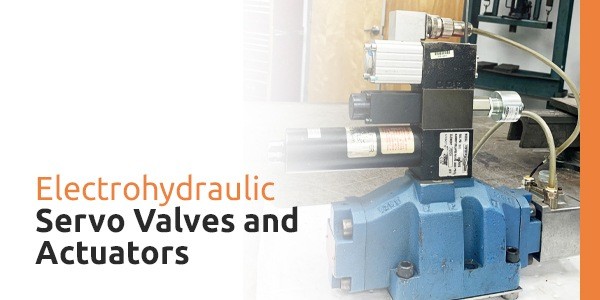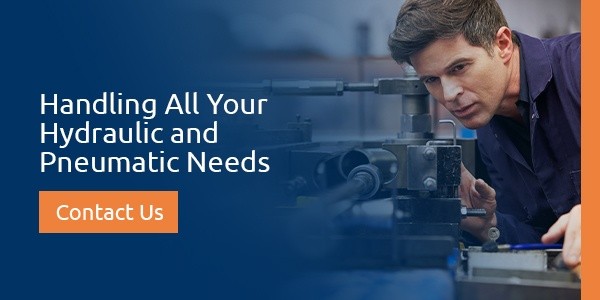Electrohydraulic Servo Valves and Actuators

Electrohydraulic Servo Valves and Actuators
Electrohydraulics or servo hydraulics are electrically controlled hydraulic devices that use an input signal to control the movement of a hydraulic device such as a valve or actuator. With regular electrohydraulic devices, an input signal is used to actuate movements by utilizing a set of coils acting as an electromagnet.
In servo hydraulics, a feedback device gives reference to an external valve controller which then uses this to determine position. In either case, electronics are present on the hydraulic device and must be considered when making the repair.
What Is an Electrohydraulic Servo Valve?
In hydraulics, a valve is any device that controls the flow of liquid. A valve can start or stop the flow, change its direction or speed and control its pressure. All of these settings depend on the application at hand. An electrohydraulic servo valve controls how the pressure-driven fluid approaches an actuator. Too much or too little pressure can be detrimental, as can be incorrect speed or direction. That’s why a hydraulic valve is such a vital part of a larger hydraulic system.
Manual controls for hydraulic valves are not always feasible or safe. Instead, an electrohydraulic servo valve uses electrical signals, allowing for remote operation. Using a digital control panel, you can send a low-power signal to your electrohydraulic valve to control its function from a distance. This way, you can turn the valve on or off or change its direction, pressure or velocity. A servo valve offers control over the position, amount of pressure, force and velocity.
The electrohydraulic servo valve then provides feedback that the actuator is performing the correct functions. Servo valves work better than other types of valves, including proportional valves, in sophisticated closed-loop systems. Such an important piece of equipment requires proper maintenance and regular inspection. Its accuracy and functionality majorly impact the entire hydraulic system. Electrohydraulic servo valve repair, including preventive maintenance, is vital for operation.
What Is a Hydraulic Servo Actuator?
An actuator is a piece of equipment that moves or controls a mechanism such as a valve. In a hydraulic system, an actuator converts hydraulic energy to make it usable. In simple terms, it turns the energy of the moving fluid into mechanical power. This is, of course, one of the most important elements of a hydraulic operation. A servo actuator is a part of a closed-loop system that operates with high accuracy and precision. A hydraulic servo actuator is an automatic device rather than a manual one.

Electrohydraulic Servo Valve and Actuator Repair
Your electrohydraulic servo valve or hydraulic servo actuator will need regular maintenance and repair. Proper, professional maintenance and repair is vital for the effective operation of any hydraulic or pneumatic equipment. It’s important to schedule regular hydraulic servo valve repair and hydraulic servo actuator repair. Certain components need inspection and may require replacement.
Every element of a hydraulic system serves an important purpose — if anything is loosened, worn down, corroded or otherwise compromised, the whole system may be unable to function. Replacing obsolete or niche parts of mechanical equipment requires access to a broad inventory. Among the parts that may need repairing or replacing are:
- Sealing components: Your equipment’ssealing components include gaskets, O-rings and seals. It’s important to make sure they’re secured in place and not loose.
- Hardware: This includes screws, bolts, washers and other fasteners. Loose fasteners can cause malfunction or pose a safety risk, so check all hardware elements often and tighten fasteners as needed. This will help you avoid any unnecessary downtime.
- The spool: Spools are an essential component. They slide or rotate to open or block channels in a hydraulic system. If the spools are not in the proper position, you’ll lose your ability to control or direct the flow of liquid.
- Spring assemblies: A faulty spring assembly can cause a malfunction for any mechanical system, so they always require adequate attention.
- Rods and chroming: The rod is a crucial part — it connects the hydraulic actuator to the component performing its function. Rods need to be inspected and repaired whenever necessary. Some of this repair might include reapplication of chroming, which helps protect the piece from corrosion and promotes smooth function.
- Wear rings: Wear rings seal against pressure leakage. This helps save energy and reduce costs — ensure they operate as intended.
- Wipers: Wipers scrape away dirt and moisture, keeping the inside of the system free from contamination. If they’re worn down or otherwise unable to function, you might risk irreparable contamination damage inside the hydraulic system.
- End bushings: Bushings ensure proper alignment for the best functionality with as little wear as possible.
- Packing seals: Packing seals are vital because they minimize fluid loss, improving the hydraulic system’s effectiveness.
- Pressure ports and return ports: Directional ports maintain the proper directional flow of fluid.
Complete inspection and maintenance of an electrohydraulic piece of equipment require both mechanical and electrical repair expertise. In addition to their mechanical components, electrohydraulic servo valves and hydraulic servo actuators have electrical elements requiring special attention. It’s essential to inspect and test any onboard electronics (OBEs) and repair them as needed in a professional electronics lab. Finally, once all elements have faced individual inspection, the complete unit must be tested along an appropriate response curve.
How Often Is Maintenance Needed?
How often your hydraulic servo valves and actuators require maintenance depends on several factors, including frequency of use and applications. It also depends on the environment surrounding the operation, including air quality and temperature. Increased use requires more maintenance, as does increased exposure to contaminants or an environment in which contaminants might thrive.
Along the same lines, exposure to extreme temperatures can cause the need for more maintenance. If you’re unsure how often you should have your equipment inspected, contact a professional service.
Frequently Asked Questions
Here are answers to some of the most frequently asked questions concerning electrohydraulic servo valve and actuator repair.
What Is the Difference Between Servo and Proportional Valves?
The line between servo and proportional valves can seem blurry. The main difference is the amount of center overlap. A servo valve has less than 3% overlap, while a proportional valve has 3% or more overlap. “Overlap” refers to how much the spool travels from its center position for opening. A tiny amount of overlap helps reduce leakage.
Where Can I Find Parts for Older Valves?
If you’re using an older piece of hydraulic equipment, you may need to replace parts that are now obsolete. You might run into obstacles as you search for replacement parts that are no longer manufactured. At Global Electronic Services, we offer access to a large inventory of parts and pieces, including those for older equipment.
Are Repairs Protected Under Warranty?
The repairs we perform are always backed with an 18-month in-service warranty. The warranty period begins when we install the new part and lasts for a full 18 months of operation.
Do You Evaluate Equipment Before Making Repairs?
We always perform an evaluation before we start making repairs. That way, you’ll have an upfront quote and will know what to expect from the repair process. We value transparency and provide fair, honest quotes.
What Should I Do in an After-Hours Emergency?
If your hydraulic equipment fails or malfunctions outside of regular office hours, please contact our emergency line at 877-249-1701 and press 1 to connect with one of our experts. You can call our emergency line 24 hours a day, every day of the year.
Handling All Your Hydraulic and Pneumatic Needs
For high-quality and effective pneumatic and hydraulic repairs and maintenance services, we’re your one-stopshop. Your company won’t need anyone else for hydraulic servo valve repair. We’ll do it quickly and successfully at a price you can afford, with a standard turnaround time of one to five days.
To find out how to get started, contact us online for a free quote or call us at 877-249-1701. We’re ready to handle all your hydraulic service needs.
